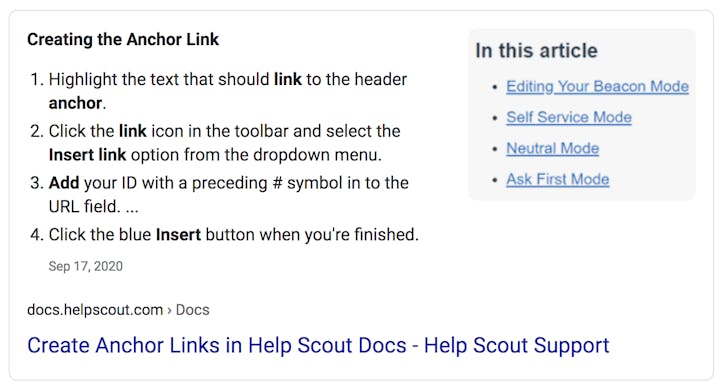5 Simple Knowledge Base SEO Tips Anyone Can Follow


You've put so much effort into your knowledge base, but if your customers struggle to find what they're looking for, it's wasted effort.
Applying some simple knowledge base search engine optimization (SEO) best practices can help your customers get the answers they need — whether they are browsing your knowledge base or searching in Google.
This is a chapter in our Ultimate Guide to Using a Knowledge Base for Self-Service Support. When you're ready, check out the other chapters:
Chapter 1 – Knowledge Base 101: Definition, Types, and Benefits
Chapter 2 – Quick Start Guide to Creating a Knowledge Base
Chapter 3 – Knowledge Base Design Tips for Better Self-Service Support
Chapter 4 – Incredible Knowledge Base Examples That Get It Right
Chapter 5 – Tips & Templates for Writing Great Knowledge Base Articles
Chapter 6 – Creating Knowledge Base Videos: Tips, Tools, and Examples
Chapter 7 – Simple Knowledge Base SEO Tips Anyone Can Follow
Chapter 8 – The Best Knowledge Base Software + How to Choose One
Chapter 9 – Actionable Knowledge Base Metrics to Start Tracking Today
Chapter 10 – Knowledge Base Tips for a Better Customer Experience
Chapter 11 – How to Revamp Your Knowledge Base Architecture
Using knowledge base SEO to improve customer success
SEO doesn't have the best reputation, so it's often hard for people to think of optimizing for search as a way to improve the customer experience. In reality:
The goal of a search engine is the same as the goal for your knowledge base: To get people the exact information they're looking for as quickly as possible.
Learning the basics of SEO helps you optimize your knowledge base articles to rank higher in search engines, making it easier for your customers to find answers to their questions. It can also help you find gaps in your existing coverage, reducing the number of questions that end up in your support queue.
You don't need to be a professional marketer to get started with knowledge base SEO — anyone can do it. Just follow the five simple steps below.
Discover the power of self‑service
Create and publish answers for customers and reduce your customer support volume by at least 20% with Help Scout Docs.
Try for free
1. Discover what your customers are searching for
If you already have a knowledge base, you probably built your content around the questions you answer most often in the support queue. You may have even expanded your content over time based on what people search for using your help center's search tool.
But SEO research can still help you find gaps you haven't covered. After all, before they ended up on your site or in your support queue, your customers may have tried to find the answers they needed by searching on Google, Bing, or another preferred search engine.
There are lots of tools that will tell you exactly what people are typing into Google regularly, but probably the most accessible for beginners is Ubersuggest — it's free, browser-based, and doesn't require an account to use.
To get started, open up Ubersuggest, type your company's name into the search tool, and click the "Search" button.

Next, scroll down to the "Keyword Ideas" section and click the "View All Keyword Ideas" button.

The next page will show you dozens — or hundreds — of keywords that contain your business name that people type into Google regularly.

In Help Scout's case, there are 174 keyword suggestions; that's 174 questions people are asking about Help Scout that we should make sure we're answering in either our knowledge base or on our marketing site.
Download that list of keywords as a CSV, or copy them to your clipboard and paste them into your preferred word processor.
You can't see how many people are searching for all of those keywords without logging in to Ubersuggest with your Google account, but you probably don't need to. If even one person is searching for these phrases each month, you should probably have information covering it.
Pro Tip: If there are other ways that customers commonly write your company's name, you may need to search for each variation, paste the keywords from each search into a document, and then remove any duplicates.
For example, people commonly write Help Scout in camel case (HelpScout), and if I run a search for "HelpScout" in Ubersuggest, I get 250 keyword suggestions — many of which are different from those in the keyword list I received when I searched for "Help Scout."
2. Find your content gaps and optimization opportunities
With your list of all of your branded keywords (i.e., keywords that contain your business name) in hand, your next step is to find out which of those keywords you're not currently ranking at the top of the search results for.
Take your list, open Google Search in incognito mode, and start searching for each of the keywords on your list.
If content from your website or knowledge base ranks in the number-one spot of the results, you can remove that keyword from your list — you already have that question answered with your content. If your content doesn't rank in the top spot, ask yourself these questions:
Do I have existing content that answers this question? If so, make a note to yourself to use the information in the sections below to better optimize that content for search.
Should this answer be a marketing page or a knowledge base article? For example, when someone searches for "Help Scout pricing," we want the pricing page on our marketing site to be the number one result, but when someone searches for "Help Scout webhooks," we want our knowledge base article to be the top result. Hand marketing keywords off to your Marketing team, and narrow your list down to those that should be answered in your knowledge base.
Is this a content gap? You may not have any content on your site answering some of the questions people are searching for. In that case, make a note next to that keyword that you need to either create a marketing page or a knowledge base article to answer that question.
Next, we'll go over how to optimize existing articles in your knowledge base that aren't ranking well, but you should use the same steps below when filling your content gaps to make sure all of your new content is optimized to rank at the top of search results.
3. Optimize your article's title
Every organic Google search result includes both a title and description:

The title of your knowledge base article is important for helping both users and search engines understand the content you cover in the article.
A lot of knowledge base article titles are written under the assumption that someone's searching for them within your website or help center. This leads to titles that are vague or unclear when they appear in search engines — for example, "How to Set Up Phone Support."
If you saw the title "How to Set Up Phone Support" in a list of Google's search results, it may not be obvious that your content is about how to set up phone support in Help Scout.
Including the specific keyword you're optimizing for in the title of your knowledge base article makes it clear to everyone — machines and people alike — what content is covered in your article. It may help your article rank higher, and it may make it easier for your customers to find the information they need.
Let's say that I'm trying to optimize an article on Help Scout's knowledge base that covers how to set up our integration with Talkdesk. I know from my keyword research that lots of people search for "Help Scout Talkdesk." A clear title for customers coming from any source might be something like:
"How to Set Up the Help Scout + Talkdesk Integration"
"How to Integrate Help Scout with Talkdesk"
"Setting Up Phone Support in Help Scout with Talkdesk"
As you can see, you don't have to make your title match the keyword you're targeting exactly, but you should try to include all of the terms (i.e., "Help Scout" and "Talkdesk").
You can also include things that people might search for alternatively when using your help center's search tool, such as "setting up phone support."
4. Make sure your title isn't too long
Another thing to keep in mind when writing the titles of your knowledge base articles is that there's a limit to the amount of space that Google provides for titles in its results. If your title is too long, it will get truncated, and all of the effort you put into writing the perfect title will be lost.

Increase your engagement on … something.
There are best practices the SEO community uses to avoid too-long titles that get truncated — recommended character counts and tools that measure the pixel width of your titles — but what I typically do to make sure my titles don't get truncated is much simpler:
Search Google for your keyword.
Look for the longest untruncated title on the page.
Copy that title and paste it without formatting into a document.
Keep your title shorter than the title you copied and pasted.
It works every time and alleviates the need to follow unreliable character count recommendations or to use special tools to measure pixel count.
But if you'd rather use a tool, this Title Tag Preview Tool from Moz works well and provides a preview of how your complete result will look in search.
5. Format your content for the web
Have you ever run across a wall of text while reading on your mobile device or tried to find the one sentence you need to solve a problem in a 5,000-word knowledge base article?
Following a few best practices of help document design will make it easier for your customers to read your content on any device and find exactly what they're looking for. And if you're doing the best job of any content online at getting searchers to the answers they need, it's much more likely that you'll also get the best rankings.
Here are a few things to keep in mind when writing your knowledge base content:
Use bullet points and numbered lists. Lists make content more skimmable and easier to read, and they're also useful when it comes to SEO because lists make it more likely that your result will show up as an expanded search result ("featured snippet").

Consider including videos and images. Including videos and screenshots may help your content rank higher, and it also lets you cater to customers with different preferred learning types (visual vs. auditory vs. reading).
Include anchor links in long content. Anchor links let readers jump to the sections they're most interested in, helping them find answers more quickly. Plus, anchor links sometimes appear under search results so users can jump directly from the results to the section they're interested in.

Optimizing your knowledge base doesn't have to be complicated
A lot of posts that cover knowledge base SEO go into great detail on the all of the highly technical tasks you need to complete to optimize your knowledge base for search, but knowledge base software like Help Scout's Docs will take care of all of the more technical tasks for you.
Then, with a bit of research and adherence to a few simple best practices, your content will rank well in search engines, you'll get fewer requests in the queue for questions you've already answered, and your customers will find the information they need to succeed with your product.
The Supportive Weekly: A newsletter for people who want to deliver exceptional customer service.


